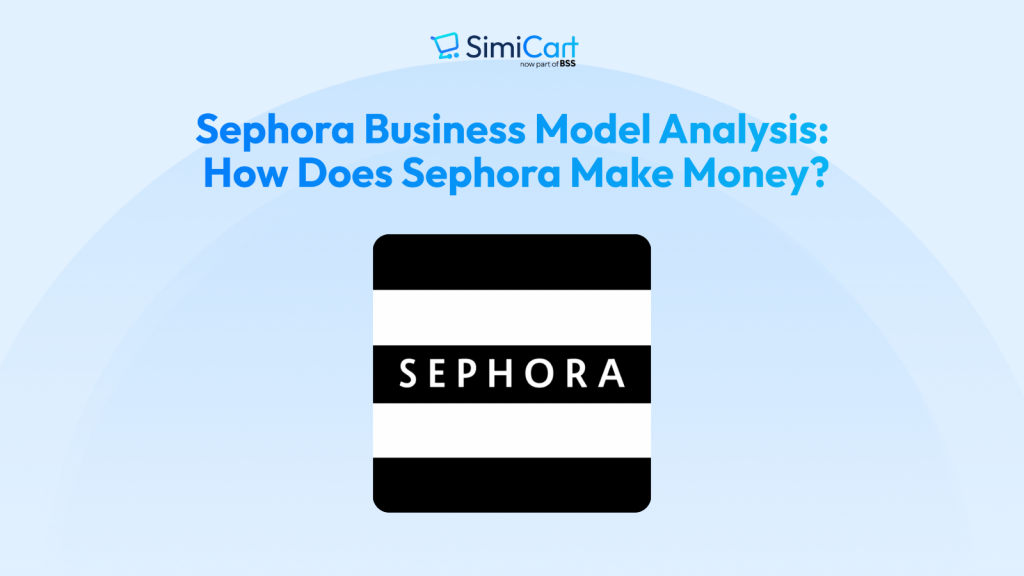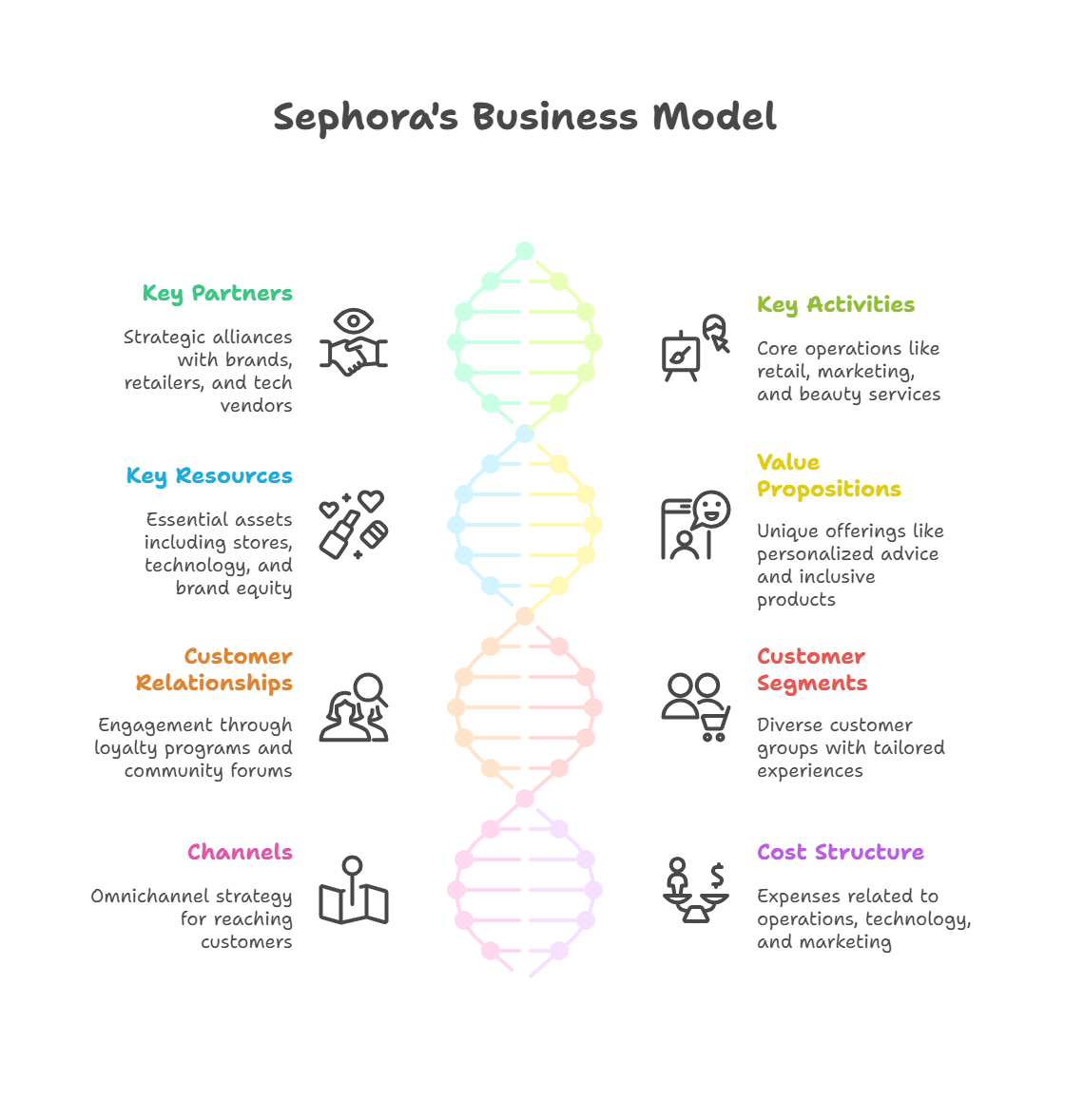Sephora Business Model Canvas Analysis: How Does Sephora Make Money?

The beauty industry has witnessed remarkable transformation over the past decade, with few companies exemplifying this evolution as successfully as Sephora. Understanding the Sephora business model reveals a masterclass in omnichannel retail, customer loyalty, and strategic partnerships that has propelled this French beauty retailer to global dominance.
Founded in 1970 and acquired by luxury conglomerate LVMH in 1997, Sephora has redefined how consumers discover, experience, and purchase beauty products. With over 2,700 stores across 35 countries and a digital presence that reaches millions of beauty enthusiasts daily, Sephora’s business model has become a blueprint for modern retail success. This comprehensive analysis will dissect how Sephora makes money, examining everything from their innovative loyalty program to their pioneering omnichannel strategy. Let’s dive in!
>> Explore:
- Sephora Marketing Strategy: Best Case Study for Shopify Brands
- Sephora Net Worth, Revenue 2024 & Growth Strategy Analysis
The Essence of Sephora’s Business Model
What is Sephora? Market Position, Ownership, and Scale
Sephora stands as the world’s leading beauty specialty retailer, operating under the LVMH umbrella alongside prestigious brands like Louis Vuitton and Dior. Since its founding in Limoges, France, Sephora has evolved from a single perfume shop into a global beauty powerhouse generating over $10 billion in annual revenue.
The company’s scale is impressive, with over 2,700 stores worldwide, partnerships with more than 340 brands, and a digital ecosystem that encompasses mobile apps, e-commerce platforms, and social commerce initiatives. Sephora’s omnichannel innovation footprint extends beyond traditional retail, encompassing augmented reality try-on experiences, AI-powered personalization tools, and community-driven content platforms.

Why Analyze Sephora’s Model? User Intent and Key Takeaways
Understanding the Sephora business model provides valuable insights into several key areas. For business analysts and competitors, it reveals how to blend digital and physical retail experiences successfully. For entrepreneurs, it demonstrates the power of community building and customer loyalty in driving sustainable growth.
Key takeaways include Sephora’s mastery of customer segmentation, their innovative approach to exclusive partnerships, and their data-driven personalization strategies that have resulted in industry-leading customer lifetime values and retention rates.
Sephora Business Model Canvas Breakdown

Key Partners
Sephora’s partnership ecosystem forms the foundation of their business model success. At the corporate level, LVMH provides financial backing, operational expertise, and access to luxury market insights. The company maintains relationships with over 340 beauty brands, from established giants like Clinique and Urban Decay to emerging indie brands and celebrity lines.
Exclusive partnerships have become a cornerstone of Sephora’s strategy. The Fenty Beauty launch in 2017, exclusive to Sephora, generated over $100 million in revenue within its first 40 days. Similarly, partnerships with Rare Beauty by Selena Gomez and other celebrity brands create unique value propositions that competitors cannot replicate.
Strategic retail partnerships, including the Sephora at Kohl’s shop-in-shop concept, expand their market reach to new demographics while providing Kohl’s customers with premium beauty experiences. Technology vendors, logistics partners, and influencer collaborations round out a comprehensive partner network that enables scalable growth.
Key Activities
The Sephora business model centers around several core activities that create competitive advantages. Wholesale buying and direct-to-consumer retail operations require sophisticated demand forecasting and inventory management systems. The company invests heavily in omnichannel technology platform development, ensuring seamless customer experiences across all touchpoints.
Marketing activities include brand launches, exclusive product debuts, and community engagement initiatives. Loyalty management through the Beauty Insider program requires dedicated resources but generates significant customer data and retention benefits. Beauty services, including makeovers, consultations, and educational classes, differentiate Sephora from pure product retailers.
Key Resources
Sephora’s resource portfolio combines physical and digital assets with intangible brand equity. Their global store network provides experiential retail environments where customers can touch, test, and try products before purchasing. E-commerce and mobile platforms, including the highly-rated Sephora app, facilitate convenient shopping and personalized experiences.
Proprietary technology resources like ColorIQ for shade matching and virtual try-on tools create competitive moats. Customer data represents perhaps their most valuable resource, enabling personalized marketing, product recommendations, and inventory optimization. Brand equity, built through consistent customer experiences and community building, supports premium pricing and customer loyalty.
Value Propositions
The Sephora business model delivers multiple value propositions that resonate with different customer segments. Their “try before you buy” open-sell environment revolutionized beauty retail by empowering customers to experiment with products freely. This approach increases confidence in purchases and reduces return rates.
Seamless digital-physical experiences allow customers to research online, try in-store, and purchase through their preferred channel. The extensive and inclusive product range ensures customers can find products regardless of their beauty needs, skin tone, or price point. Expert personalized advice, whether through in-store consultations or AI-powered recommendations, adds significant value to the shopping experience.
Customer Relationships
Sephora’s approach to customer relationships centers on the Beauty Insider community platform, which boasts over 17 million active members. This tiered loyalty program (Insider, VIB, Rouge) provides increasingly valuable benefits based on annual spending, encouraging customer progression and retention.
The community forum enables peer-to-peer advice, user-generated content, and brand engagement that builds authentic relationships beyond transactional interactions. Proactive customer support, expert consultation services, and AI-powered personalization tools ensure customers receive relevant, helpful experiences across all touchpoints.
Customer Segments
Sephora’s business model effectively targets multiple customer segments through tailored experiences and product offerings. Beauty enthusiasts represent their core segment, seeking the latest products, trends, and exclusive launches. Professional makeup artists and skincare specialists require high-quality products and expert-level services.
Generation Z and millennial customers drive significant growth, attracted by inclusive brand values, social media integration, and digital-first experiences. Eco-conscious customers increasingly seek clean beauty options and sustainable practices. Gift shoppers represent a significant seasonal opportunity, supported by curated gift sets and convenient packaging options.
Channels
Sephora’s omnichannel strategy is a critical component of its business model, enabling the company to reach and engage customers across multiple touchpoints.
- Physical Stores: 2,700+ stores worldwide offer hands-on experiences like makeovers, product testing, and consultations, driving loyalty and in-store purchases.
- E-commerce Website: A robust online platform with full product access, virtual try-ons, and personalized features, supporting global, 24/7 shopping.
- Mobile App: User-friendly app with AR tools, mobile-exclusive deals, and loyalty integration, boosting engagement among mobile-first users.
- Social Media: Active on TikTok, Instagram, and YouTube with influencer campaigns, shoppable posts, and UGC that build brand buzz and community.
- Retail Partnerships: Shop-in-shops like Sephora at Kohl’s expand reach to new demographics with curated offerings and dual loyalty rewards.
- Email & Beauty Insider: Personalized emails and loyalty updates for 17M+ members drive repeat purchases, exclusive access, and tier engagement.
- Events & Community: In-store and virtual events, expert sessions, and launch parties create immersive brand experiences and customer connection.
>> Get more insight about Sephora App at: Sephora App: Deep Analysis And Key Take Away To Build an eCommerce app

Sephora mobile app and website
Tips: For Shopify store owners who want to reach more customers on mobile without the hassle of coding or expensive development, Simicart is the easiest no-code mobile app builder that allows you to quickly create and launch your own iOS and Android apps. Unlike complex or costly solutions, Simicart offers a simple drag-and-drop interface and a free plan to effortlessly tap into the power of mobile commerce.
Cost Structure
Sephora’s cost structure reflects its premium positioning and omnichannel approach. Key costs include:
- Inventory and Procurement: Wholesale purchasing of products from over 340 brands, including exclusive and indie lines, requires significant investment.
- Retail Operations: Rent, maintenance, and staffing for thousands of global stores represent a major expense.
- Technology Development: Investment in e-commerce platforms, the Sephora app, and proprietary tools like ColorIQ and virtual try-ons drives digital innovation.
- Marketing and Branding: Costs for exclusive launches, influencer collaborations, social media campaigns, and loyalty program management are substantial.
- Logistics and Distribution: Operating a global supply chain, including warehousing and shipping, incurs significant costs, especially for fast delivery options.
- Beauty Services: Providing in-store consultations, makeovers, and classes requires trained staff and dedicated resources.
- Administrative and Overhead: Corporate functions, including HR, finance, and LVMH-related expenses, contribute to operational costs.
How Does Sephora Make Money? Core Revenue Streams
Primary Revenue Drivers
The Sephora business model generates revenue primarily through product sales, which account for approximately 85-90% of total revenue. These sales include both third-party brands and Sephora Collection private label products, with private label items typically generating higher margins (40-60% vs. 30-45% for branded products).
Beauty services, including makeovers, consultations, and educational classes, contribute both direct revenue and indirect benefits through increased product sales and customer loyalty. While services represent a smaller percentage of total revenue, they significantly impact average order value and customer lifetime value.
Ecommerce vs. In-Store Revenue Contributions
Digital channels now represent approximately 30-40% of Sephora’s total revenue, with this percentage continuing to grow. The COVID-19 pandemic accelerated digital adoption, with online sales growing over 60% in 2020. However, the integrated nature of Sephora’s omnichannel model means many transactions involve both digital and physical touchpoints.
Buy-online-pickup-in-store (BOPIS) services and digital research followed by in-store purchases demonstrate the interconnected nature of their revenue streams. This integration makes Sephora’s model particularly resilient compared to purely online or offline competitors.
Exclusive Partnerships and Brand Collaborations
Exclusive launches and partnerships drive significant revenue spikes while building customer loyalty. The Fenty Beauty exclusive launch generated massive social media buzz and attracted new customer segments to Sephora. These partnerships create win-win scenarios: brands gain access to Sephora’s customer base and retail expertise, while Sephora benefits from exclusive inventory and increased customer traffic.
Limited-time collaborations with influencers and celebrities generate urgency and social media engagement that translates to sales. These partnerships often result in higher conversion rates and average order values compared to standard product launches.

Unique Differentiators in Sephora’s Business Model
Assisted Self-Service Store Concept & Open Sell Environment
Sephora pioneered the open-sell beauty retail concept, allowing customers to freely test and experiment with products. This approach builds confidence and reduces purchase anxiety, particularly for higher-priced items. The assisted self-service model provides knowledgeable staff when needed while empowering customer autonomy.
This strategy has proven highly effective, with studies showing that customers who test products in-store have conversion rates 3-4 times higher than those who don’t. The approach also encourages discovery of new products and brands, increasing average order values.
Data-Driven Personalization & Digital Strategy
The Sephora business model leverages customer data to create highly personalized experiences. ColorIQ technology uses advanced color-matching algorithms to recommend perfect foundation shades, while virtual try-on features allow customers to experiment with makeup looks from home.
Cross-channel data integration enables personalized marketing campaigns, product recommendations, and inventory management. Customers receive relevant offers based on purchase history, browsing behavior, and stated preferences, resulting in higher engagement rates and conversion.
Community-Led Growth
Sephora’s Beauty Insider Community has grown to over 3 million active members who generate user-generated content, provide peer advice, and create authentic brand engagement. This community-driven approach builds stronger emotional connections than traditional marketing approaches.
The platform generates over 200,000 product reviews monthly, providing valuable social proof and product feedback. Community members spend 10 times more than non-members and have significantly higher retention rates, demonstrating the model’s effectiveness.
The Power of Omni-Retail – Sephora’s Digital & Physical Synergy
Omnichannel Innovations
Sephora’s omnichannel innovations include industry-leading features like same-day delivery, curbside pickup, and virtual consultations. Their mobile app, rated 4.9 stars with millions of downloads, provides features like barcode scanning for instant product information and AR-powered try-on experiences.
The “Reserve and Try in Store” feature allows customers to secure products online and test them in-store before finalizing purchases. These innovations have resulted in increased conversion rates and improved customer satisfaction scores.
Seamless Online-to-Offline Experience
Customer journey mapping reveals that over 70% of Sephora customers use multiple channels during their purchase process. The Beauty Insider program bridges online and offline experiences, with points earned and redeemed across all channels.
Customers might discover products through social media, research on the mobile app, test in-store, and complete their purchase online for home delivery. This seamless integration reduces friction and improves customer satisfaction.
Sephora’s Customer Loyalty Engine: Beauty Insider & Beyond
Structure of the Program
The Beauty Insider program features three tiers based on annual spending: Insider (free), VIB ($350+ annually), and Rouge ($1,000+ annually). Each tier provides increasing benefits including points acceleration, exclusive access to sales, free shipping, and special experiences.
Rouge members, representing less than 5% of the customer base, generate approximately 25% of total revenue, demonstrating the program’s effectiveness in driving customer value concentration.
Quantified Impact
Beauty Insider members spend 15 times more than non-members and have retention rates exceeding 80% compared to 35% for non-members. The program generates valuable customer data that enables personalization and drives higher lifetime values.
Members redeem points for deluxe samples, full-size products, and exclusive experiences, with redemption rates remaining consistently high, indicating strong program engagement and perceived value.
Target Audiences & Segmentation
Core Customer Segments
Sephora’s business model effectively serves diverse customer segments through targeted approaches. Beauty enthusiasts seek the latest trends and exclusive products, while professional artists require high-performance products and bulk purchasing options.
Gen Z customers (ages 18-24) represent the fastest-growing segment, attracted by inclusive marketing, social media integration, and digital-first experiences. This segment shows higher engagement with user-generated content and influencer collaborations.
How Segmentation Informs Strategy
Different segments receive tailored marketing messages, product recommendations, and experiences. Professional artists access educational content and bulk purchasing options, while casual users receive beginner-friendly tutorials and starter sets.
Personalization engines analyze customer behavior to determine segment membership and customize experiences accordingly, resulting in higher engagement and conversion rates across all segments.
FAQs about Sephora’s Business Model
What are Sephora’s main revenue streams?
Sephora generates revenue primarily through product sales (85-90%), including both branded and private label items, beauty services, exclusive partnerships, loyalty program benefits, and shop-in-shop partnerships.
How does Beauty Insider affect Sephora’s profitability?
Beauty Insider members spend 15 times more than non-members and have 80% retention rates. The program generates valuable customer data for personalization while reducing marketing costs through targeted campaigns.
What’s unique about Sephora vs. Ulta/competitors?
Sephora’s open-sell environment, exclusive partnerships, community platform, and omnichannel integration create differentiation. Their focus on premium and prestige brands versus Ulta’s mass-market approach targets different customer segments.
Is Sephora’s private label a threat to other brands?
Sephora Collection provides accessible price points and fills product gaps rather than directly competing with partner brands. The private label strategy complements rather than cannibalize branded sales.
How sustainable is the Sephora model in 2025+?
Sephora’s diversified revenue streams, strong digital capabilities, and community-driven growth provide resilience. Continued investment in sustainability, inclusivity, and technology positions them well for future challenges.
Actionable Takeaways: What Can Ecommerce Brands Learn from Sephora?
Lessons in Community Building for Brand Loyalty
Build platforms that enable customer-to-customer interactions and user-generated content. Invest in community management and create opportunities for customers to share experiences and advice.
Revenue Diversification Strategies
Don’t rely solely on product sales. Consider services, subscriptions, exclusive partnerships, and data monetization opportunities that align with your brand values and customer needs.
Crafting Omnichannel Experiences
Ensure consistent experiences across all touchpoints while leveraging the unique strengths of each channel. Invest in technology that connects online and offline customer interactions.
Winning with Personalization and Data
Collect and analyze customer data to create personalized experiences, but ensure transparency and value exchange. Use data to improve product recommendations, marketing relevance, and customer service.
Conclusion
The Sephora business model represents a masterclass in modern retail execution, successfully blending digital innovation with experiential physical retail. Their success stems from understanding that today’s beauty consumers seek more than just products—they want experiences, community, and personalization.
Key elements that make the Sephora business model successful include their omnichannel integration, data-driven personalization, community building, and strategic partnerships. The Beauty Insider program demonstrates how loyalty initiatives can drive both customer retention and valuable data collection when executed thoughtfully.
For businesses looking to compete in today’s retail environment, Sephora’s model offers valuable lessons in customer experience design, revenue diversification, and technology integration. The company’s continued investment in sustainability, inclusivity, and innovation positions them well for future growth while setting industry standards for customer-centric retail.
Build Your Own Beauty (or Retail) App Like Sephora Without Coding
Ready to create your own engaging retail experience? SimiCart helps Shopify businesses build native mobile apps that rival major retailers’ functionality without any coding required.
Transform your Shopify store into a powerful mobile app featuring push notifications for exclusive launches, personalized product recommendations, and seamless loyalty program integration. With SimiCart’s drag-and-drop builder, you can create the same engaging experiences that make Sephora’s business model so successful.
Start your free trial today and discover how a native mobile app can boost customer loyalty, increase repeat purchases, and grow your average order value—just like the beauty industry leaders.

